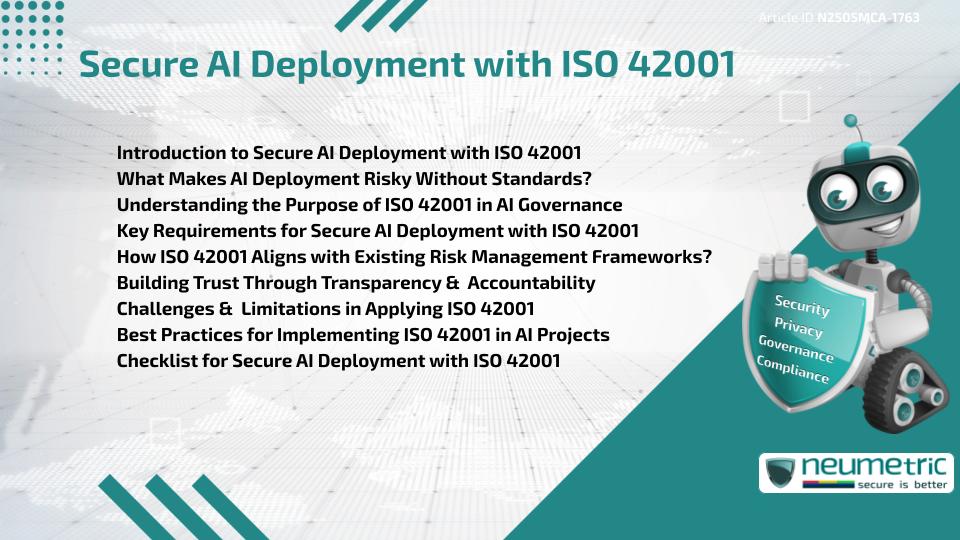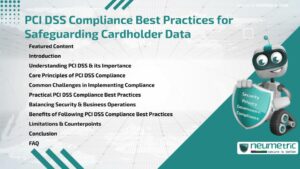Table of Contents
ToggleIntroduction to Secure AI Deployment with ISO 42001
Artificial Intelligence [AI] is revolutionising how businesses operate—but without proper controls, its use can pose serious ethical, legal & operational Risks. To help address these concerns, ISO introduced ISO 42001, the first international Standard for AI Management Systems. Organisations that follow this Framework can ensure secure AI deployment with ISO 42001 by embedding accountability, transparency & safety into their AI Development & deployment lifecycle.
This article explores how ISO 42001 supports responsible AI deployment, outlines key requirements & offers practical strategies for aligning AI SystemsAI with its principles.
What Makes AI Deployment Risky Without Standards?
Unlike traditional software, AI Systems can behave unpredictably, adapt in real-time & process Sensitive Data. Without a structured approach, Organisations Risk:
- Bias in automated decisions
- Security Vulnerabilities in AI Models
- Non-Compliance with regulations
- Lack of traceability & explainability
In short, deploying AI without Governance is like launching a rocket without guidance systems. That’s why secure AI deployment with ISO42001 matters—because it gives structure to innovation.
Understanding the Purpose of ISO 42001 in AI Governance
ISO 42001 provides a comprehensive Framework to help Organisations design, implement & maintain an AI Management System [AIMS]. The goal is not to stifle innovation but to ensure AI technologies are safe, ethical & aligned with human values.
The Standard covers:
- Risk identification & mitigation
- Data quality & Privacy controls
- Human oversight & decision-making
- System transparency & auditability
- Lifecycle management of AI Models
With these elements in place, secure AI deployment with ISO 42001 becomes achievable for enterprises of any size.
Key Requirements for Secure AI Deployment with ISO 42001
The core of ISO 42001 resides in translating principles into action. Some of the critical requirements include:
- Governance Structure: Clear roles & responsibilities for managing AI-related Risks
- Risk Assessment: Actively identifying AI-specific Threats across lifecycle stages
- Monitoring Mechanisms: Continuous evaluation of AI behaviour & performance
- Transparency Controls: It explains the mechanisms of how AI Systems make decisions
- Human-Centered Design: Ensuring meaningful human involvement in critical outcomes
Meeting these criteria supports secure AI deployment with ISO 42001 & helps to build Stakeholder trust.
How ISO 42001 Aligns with Existing Risk Management Frameworks?
ISO 42001 doesn’t operate in isolation. It complements existing standards like:
- ISO 27001 for Information Security
- ISO 31000 for Risk Management
- NIST AI Risk Management Framework
- OECD AI Principles
- UNESCO Recommendation on AI Ethics
This interoperability makes secure AI deployment with ISO 42001 more practical for Organisations already familiar with these systems.
Building Trust Through Transparency & Accountability
Trust is the foundation of AI adoption. ISO 42001 reinforces this through:
- Clear Documentation: Record how AI Systems are designed & used
- Audit Trails: Maintain logs of decision processes & outcomes
- Stakeholder Engagement: Communicate AI impact clearly to affected parties
- Defined Escalation Paths: Prepare for when things go wrong
By emphasising openness & accountability, secure AI deployment with ISO 42001 encourages responsible use & fosters User confidence.
Challenges & Limitations in Applying ISO 42001
While the Standard provides strong guidance, challenges remain:
- Complex Implementation: Smaller Organisations may struggle with resources
- Evolving Technology: AI Systems change fast, requiring constant updates
- Interdisciplinary Needs: Requires collaboration between tech, legal & ethics teams
These limitations don’t negate the value of the standard, but they highlight the need for tailored approaches in secure AI deployment with ISO 42001.
Best Practices for Implementing ISO 42001 in AI Projects
To put ISO 42001 into practice, consider these steps:
- Start with a Gap Analysis to assess current maturity
- Create a multidisciplinary Governance team
- Document use cases, Risks & expected outcomes
- Conduct training & awareness sessions
- Review & update your AIMS regularly
Embedding these steps supports a scalable & sustainable approach to secure AI deployment with ISO 42001.
Checklist for Secure AI Deployment with ISO 42001
Here’s a simplified checklist to guide implementation:
- Is an AI Governance Framework in place?
- Are AI-specific Risks identified & mitigated?
- Is human oversight defined for high-impact decisions?
- Are data sources validated & bias-checked?
- Can the system’s decisions be explained & audited?
- Are Stakeholders informed of AI use & implications?
- Are controls in place to monitor system performance over time?
Using this checklist ensures consistent & secure AI deployment with ISO 42001 across different teams & projects.
Takeaways
- AI poses unique Risks that require structured Governance.
- ISO 42001 offers a steady foundation for responsible AI use.
- Secure AI deployment with ISO 42001 involves aligning ethics, safety & transparency.
- Practical tools like checklists & gap analyses support effective implementation.
- Collaboration across teams is essential for long-term success.
FAQ
What is ISO 42001 & why it is important for AI deployment?
ISO 42001 is the first international Standard that manages AI Systems.It provides a structured approach to ensure AI technologies are safe, ethical & trustworthy.
How does ISO 42001 help secure AI deployment?
It establishes guidelines for identifying Risks, ensuring transparency & maintaining oversight throughout the AI System lifecycle.
Can ISO 2001 be used with other Compliance frameworks?
Yes, it complements standards like ISO 27001, ISO 31000 & the NIST AI Risk Management Framework for broader Governance.
Is ISO 42001 suitable for startups or are only for bigger Organisations?
ISO 42001 is flexible & can be adapted to different organisational sizes with varying levels of complexity.
What are the biggest issues faced while adopting ISO 42001?
Challenges include resource constraints, rapid AI evolution & the need for cross-functional collaboration between technical & non-technical teams.
How do I start implementing ISO 42001?
Begin with a Gap Analysis to identify current weaknesses, then establish Governance, assess Risks & build an AI Management System.
Does ISO 42001 require human Supervision of AI Systems?
Yes, especially for high-Risk use cases. It encourages meaningful human control in critical decisions.
How often should AI Systems be reviewed under ISO 42001?
Review should be continuous, especially as models evolve or data inputs change, to maintain effective & secure AI deployment with ISO 42001.
Need help?
Neumetric provides organisations the necessary help to achieve their Cybersecurity, Compliance, Governance, Privacy, Certifications & Pentesting goals.
Organisations & Businesses, specifically those which provide SaaS & AI Solutions, usually need a Cybersecurity Partner for meeting & maintaining the ongoing Security & Privacy needs & requirements of their Clients & Customers.
SOC 2, ISO 27001, ISO 42001, NIST, HIPAA, HECVAT, EU GDPR are some of the Frameworks that are served by Fusion – a centralised, automated, AI-enabled SaaS Solution created & managed by Neumetric.
Reach out to us!





